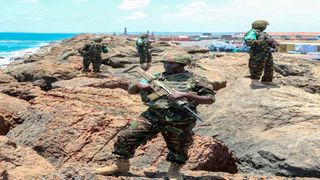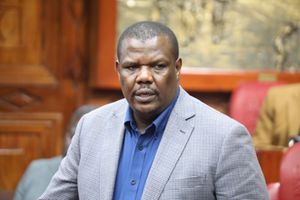
Kenya Defence Forces soldiers serving under the African Union Mission in Somalia (Amisom) guard Kismayo seaport on October 6,2021.
| Mary Wambui | Nation Media GroupNews
Premium
Operation Sledge Hammer: How KDF captured Kismayu
What you need to know:
- The first challenge was learning how to operate in the sea since most of his men were used to land assaults.
- The voyage to Kismayu began at night from Manda Bay and a clear navigation route was established in the open sea.
On September 28, 2012, Kenya Defence Forces (KDF) launched a daring amphibious assault on the port of Kismayu and wrestled it from the control of Al-Shabaab militants.
As troops landed on the beach, locals took cover to avoid being caught up in the middle of a carefully planned raid that started at around 3am.
“It was an amphibious assault, delicate and meticulously planned. We have so far encountered minimum resistance,” said Colonel Cyrus Oguna, then-KDF spokesman.
Speaking to the Nation yesterday, Lieutenant Colonel Douglas Mbulukhu, the man who led the advance team that made way for the attack, revealed the intricacies of the operation.
Their responsibility was to form a beachhead security line for the raid. They were 56 men from the Rangers Strike Force, backed by 20 from the Navy Diving Unit.
The events had been set in motion on September 25, 2012, when then-KDF chief Julius Karangi visited Manda Bay and gave the mission a go-ahead.
Gen Karangi, under whose command KDF crossed the border in October 2011 to fight Al-Shabaab, said they had been hitting the tail and body of the militants, but it was time to hit the head, which was Kismayu.
“We’ve been hitting the tail and the body of the Al-Shabaab, (and) we now want to hit the head, and the best weapon to do so is a hammer; a sledge hammer. You are the sledge hammer that is going to hit the head,” he said.
“We had been training for three weeks but nobody knew about going to Kismayu. To us, it was just the normal training in readiness for anything,” Lt Col Mbulukhu said.
The first challenge was learning how to operate in the sea since most of his men were used to land assaults.
Marine training
“We had to undergo marine training and be ready for the operation. The operation was to be executed by the coordinated action of land, sea and air forces. Our mission was to ensure the environment was secure for the main troops to land in Kismayu,” he said.
On September 25, the team set off towards Kismayu on KNS Jasiri, a naval ship. “Our mission was to ensure the main force transits from sea to land comfortably and any attack at this moment would mean a huge loss on our side,” said Lt-Col Mbulukhu.
KNS Jasiri was only two months old when it was deployed. The voyage to Kismayu began at night from Manda Bay and a clear navigation route was established in the open sea.
“All the briefing on how to behave on the ship was done and a final security order to avoid friendly fire was delivered,” he said.
While at sea, the soldiers developed motion sickness. It’s a result of a conflict in the inner ear caused by a vessel’s erratic motion on the water. The condition causes cold sweats, nausea and vomiting.
“Sea sickness hit most personnel that night as the sea became too rough. Our adrenaline was just too high because of what we were going to do but there was no retreat,” Lt Col Mbulukhu said.
At about 5pm on September 26, the ship approached the projected area. “Our plan was to disembark that evening and get into the security formation on land before moving further inside under the cover of darkness, but that never happened,” he said.
The sailors lowered the boats from the ship. “We only had one crane to lower all the nine boats and they were to be maintained around the ship to allow lowering of equipment. It took almost an hour,” he said.
But after all the boats had been lowered, the sea became rough, hampering progress.
Seasickness
“It was dark, visibility was poor, and the ship was rocking violently. Two of the nine boats we were to use to the shore just disappeared. The situation affected communication. Nobody was telling us anything about the challenges they were facing. It was until midnight that the diving unit and the crew said we could not launch the operation that night, so we retreated into the deep sea,” he recalled.
“With seven boats, we had to reduce the number of personnel to the shore as each had a capacity of five. We reduced our men by 10 while the Navy reduced theirs by four. We got to the launch area at about 5.30pm, which was about eight kilometres into the sea from the land.”
In the second attempt, the mission was fast. At 8pm, the mission began and the seven boats headed to the shore. “I was given the green light to secure the beach. The reality dawned on me that I was now to deal with a real enemy and that was a whole experience and it defined my military life,” said Lt-Col Mbulukhu.
“We headed south-west just past our objective area for security reasons and we reached the shore. Some of us were weak due to seasickness but they looked prepared and determined,” he said.
With less than two kilometres to the shore, Lt Col Mbulukhu ordered that they take a shorter route since they were late by an hour.
“There was the risk of using the rubber boats because once shot at, they would deflate and everyone would sink,” he said. As the team prepared to land, one of the boats was hit by strong waves and the colonel fell off. The same boat was washed again immediately back into the sea, leaving me alone on shore. I could not swim into the sea because of the strong waves. This happened within a few minutes,” he said.
Shortly after, he was joined by the other men on shore. The delay in arriving at the beach was a blessing since the waters were moving towards the shore, boosting their security.
“This was an area characterised with high surf onshore and our delay helped us get here when the area was filled up with water. We immediately established the security line and reported back to the commander of the 3rd Battle Group (3BG) for him to start preparing for landing,” he said.
Only 46 men provided security to the main force that took Kismayu from Al-Shabaab.
Heavy blast
The 3BG was led by Colonel William Kamoiro, who revealed in his book titled The Soldiers’ Legacy, that training of the troops was conducted at Manda Bay while that of commanders and divers was undertaken in Mkunguni between September 7 and September 23, 2012.
In the book, Colonel Kamoiro said embarkation began on September 23 at Mkunguni and was completed on September 25 when 3BG troops, vehicles, weapons and logistics were loaded onto naval vessels. The rough sea could not allow firing of the mortars into land to destroy the enemy.
During their movement from the beach, they encountered nobody but could see vehicles along the Kismayu-Mogadishu Road. “We were fully aware that there were no activities at our landing area at night from our intelligence but these vehicles were raising eyebrows,” he said.
The anti-tank weapons teams prepared to hit the vehicles but their commander called it off. “I informed Col. Kamoiro of the situation and asked him to land. I had a small team that could not sustain a fight for a long period and that is why I asked the main force to come as fast as possible,” Lt Mbulukhu said.
All the soldiers forming the beachhead team had more than enough ammunition but were few in number. The waves still affected docking of the vessels carrying the main force and the captains had to derive ways of positioning them.
“Our soldiers could not use the ramp to disembark but used the rope to get off. It was tiring to get our men on the ground and I think I slept off,” Lt-Col Mbulukhu said.
He was awoken by a heavy blast and realised that the main force had fired two mortars. It was a mistake as it broke the silence and alerted the enemy. “It was past 5am and the day was breaking as visibility got clear. We could see the quarries where the militants were hiding,” he said.
KDF began by firing mortars into the quarries to destabilise the enemy.
“Within no minute, we had helicopters firing from the skies and the militants got confused. Our plan worked well despite the challenges at sea,” he said.
Kismayu was a strategic town for Al-Shabaab and a bastion for their terror and piracy activities. It was regarded as the militants’ last major stronghold on account of the revenue they had been able to generate through exporting charcoal and levying port taxes on imported goods.





